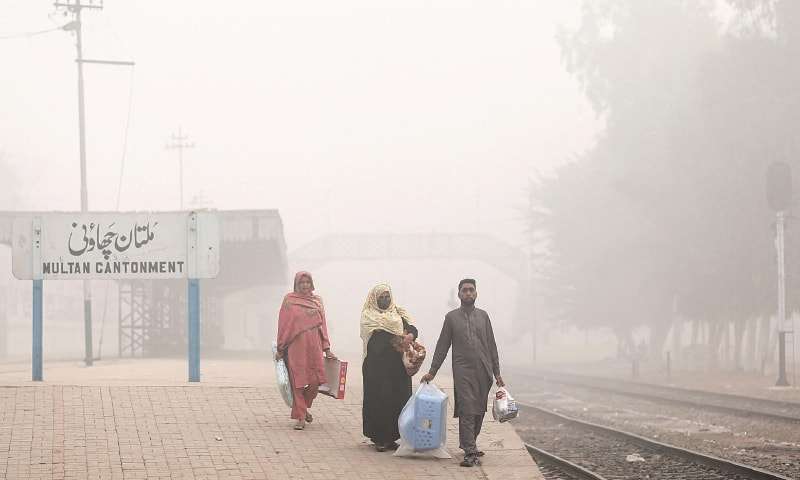Introduction
The smog situation in Punjab has escalated alarmingly, with Multan’s Air Quality Index (AQI) surpassing the 2,000 mark, prompting severe restrictions and emergency measures from the provincial government. This article delves into the details of the smog crisis, the government’s response, and the broader implications for public health and daily life in Punjab.
The Smog Crisis in Punjab
Multan’s Record-Breaking AQI Levels
On Friday morning, Multan, the largest city in south Punjab, recorded an unprecedented AQI reading of 2,135, according to IQAir, a Swiss air quality monitor. This marks one of the highest air pollution levels ever recorded in the region. The concentration of PM2.5—fine particulate matter in the air that poses significant health risks—was recorded at 947 micrograms per cubic meter, which is a staggering 189.4 times above the World Health Organization (WHO) guideline.
AQI Levels and Health Implications
- WHO Guideline: Anything over five micrograms per cubic meter is considered hazardous.
- Multan’s Levels: At 947 micrograms per cubic meter, the air quality in Multan poses severe health risks, including respiratory and cardiovascular issues.
Government’s Response and Measures
The provincial government has taken stringent measures in response to the worsening air quality. Parks and museums have been closed until November 17, and sections of major motorways have been shut down to reduce vehicular emissions. Additionally, a ‘smart lockdown’ has been imposed in Multan, requiring markets to close by 8 PM and enforcing strict action against vehicles emitting excessive smoke.
Smart Lockdown and Public Safety Measures
- Closure of Public Spaces: Parks, museums, and other public spaces have been closed.
- Market Restrictions: Markets must close by 8 PM.
- Traffic Regulations: Strict action against vehicles emitting smoke.
- Crackdown on Stubble Burning: Enforcement against illegal stubble burning and non-compliant brick kilns.
The Blame on Cross-Border Winds
Officials in Punjab have attributed the severe smog to cross-border winds from India. According to Punjab Environment Protection and Climate Change Department (EPCCD) Secretary Raja Jahangir Anwar, a wind phenomenon from the Indian cities of Bikaner and Jaipur has exacerbated the smog situation in south Punjab, including Bahawalpur, Multan, and Rajanpur.
Environmental Factors
- Cross-Border Winds: Winds from Indian cities contribute to the smog.
- Local Emissions: Industrial emissions, vehicular pollution, and stubble burning also play significant roles.
Impact on Daily Life and Public Health
Health Hazards and Hospital Preparations
The hazardous air quality has prompted Nishtar Hospital in Multan, the city’s largest medical facility, to establish smog counters in its OPD and emergency wards. However, these counters had not received any patients at the time of reporting.
Health Risks
- Respiratory Issues: Increased cases of sore throat, asthma, and other respiratory problems.
- Cardiovascular Problems: Higher risk of heart attacks and strokes.
Public Reactions and Compliance Issues
Despite government directives, compliance has been an issue. Residents like Rao Noushad reported children playing outside and people ignoring the restrictions, highlighting the challenges in enforcing these measures.
Public Feedback
- Non-Compliance: People not adhering to lockdown and safety measures.
- Health Complaints: Increased health complaints from residents due to poor air quality.
Government’s Broader Efforts
Environmental Regulations and Fines
Senior Minister Marriyum Aurangzeb emphasized the government’s efforts to curb smog, including directives for cargo trucks to cover their loads and actions against private generators and polluting vehicles. Authorities have seized vehicles, issued fines, and closed food stalls violating environmental regulations.
Regulatory Actions
- Vehicle Seizures and Fines: Seizing polluting vehicles and imposing fines.
- Closure of Non-Compliant Outlets: Shutting down businesses violating environmental standards.
Impact on Transportation
The smog has also affected transportation, with key roads and motorways closed due to reduced visibility. This has disrupted travel and logistics, further impacting daily life in the region.
Road Closures
- Motorway Shutdowns: Sections of the Lahore-Abdul Hakeem M3 and Lahore-Islamabad M2 motorways closed.
- Travel Disruptions: Significant disruptions to road travel and logistics.
FAQs
1. What is the current AQI level in Multan?
The AQI level in Multan recently crossed the 2,000 mark, indicating extremely hazardous air quality.
2. What measures has the government taken to address the smog?
The government has imposed a ‘smart lockdown,’ closed parks and museums, and enforced strict traffic regulations and crackdowns on stubble burning and polluting industries.
3. How does the smog affect public health?
The high levels of PM2.5 can cause severe respiratory and cardiovascular issues, increasing the risk of asthma, heart attacks, and strokes.
4. What role do cross-border winds play in the smog situation?
Cross-border winds from Indian cities like Bikaner and Jaipur have contributed to the smog in south Punjab, exacerbating the pollution levels.
5. What are the consequences of non-compliance with government directives?
Non-compliance can lead to fines, seizures of vehicles, and closure of businesses. It also poses significant health risks to the public.
Conclusion
The smog crisis in Punjab, particularly in Multan, has reached unprecedented levels, prompting severe government measures and raising significant public health concerns. While the government continues to enforce restrictions and blame cross-border winds, the immediate focus remains on mitigating the health risks and ensuring compliance with safety measures.
ALSO READ:
https://flarenews.pk/2024/11/09/pm-shehbaz-sets-25-billion-target-for-pakistan-it-exports/



